FHWA-HEP-20-003
Printer-friendly PDF →
FHWA Eco-Logical Case Studies Series
Example of Implementing Eco-Logical
Year Two Snapshot: Maine Department of Transportation Atlantic Salmon Programmatic Consultation
Agency: Maine Department of Transportation (MaineDOT)
Eco-Logical Snapshots check in with transportation agencies around the country that are already utilizing the later stages of the Eco-Logical approach to expedite project delivery and achieve environmental outcomes. These Snapshots focus on cost and time savings achieved through better integration of infrastructure development and conservation.
This case study is the second year follow-up to the Atlantic Salmon Programmatic developed by FHWA and Maine Department of Transportation (MaineDOT) that incorporated concepts from the Eco-Logical approach.
The first year follow-up, the Year One Snapshot, summarizes the cost and time savings realized in the first full year of the programmatic consultation in action.
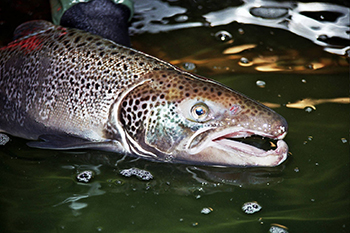
Adult Atlantic salmon (Courtesy of USFWS)
The Atlantic Salmon Programmatic Consultation saw its second full year of implementation in 2018, building on initial successes and continuing improvements in overall efficiency and review timelines. Not only has the programmatic led to significant habitat restoration for the Atlantic salmon, but it has also helped improve trust and cooperation among agencies, increased predictability, saved time and money, and improved the resiliency of completed projects.
In its second year, MaineDOT focused on ways to enhance the program and increase project coverage. The monitoring of completed projects has improved regulatory compliance and ensured beneficial environmental outcomes, while adaptive management has allowed MaineDOT and its partners to incorporate new information to adjust the program to meet efficiency and conservation goals. The In-Lieu Fee (ILF) program, which was finalized at the end of 2018, is another tool that can add further flexibility to the programmatic consultation process.
Year Two At-a-Glance
In its second full year of implementation, MaineDOT and its partners continue to see positive results. In 2018, the programmatic consultation process has led to:
- 56% faster processing of formal consultations compared to 2017
- 56% increase in number of completed consultations compared to 2017
- 188 habitat units of critical habitat for Atlantic salmon restored
- 36 projects reviewed and 14 projects completed
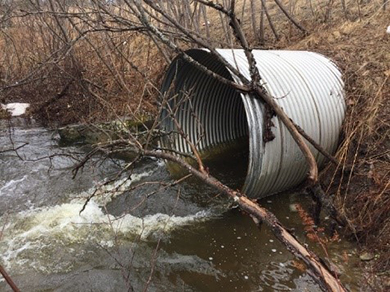
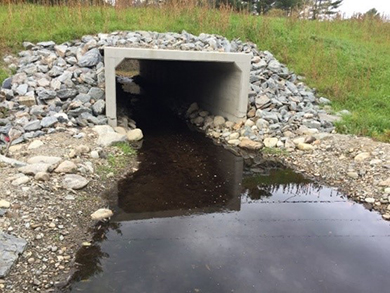
Before (left) and after (right) Route 139 Winterport Culvert Replacement (Courtesy of MaineDOT)
Growth in the Right Direction
Entering into its second year, the programmatic consultation has continued to meet the following goals:
- Decrease permitting time
- Improve predictability
- Reduce costs and duplicative efforts
- Foster resource agency partnerships
- Improve outcomes for Atlantic salmon and critical habitat
- Improve highway asset resiliency and safety
It has also allowed MaineDOT to further implement all facets of the Eco-Logical approach including:
- Post-construction monitoring
- Adaptive management
- Compensatory mitigation using an in-lieu fee (ILF) program
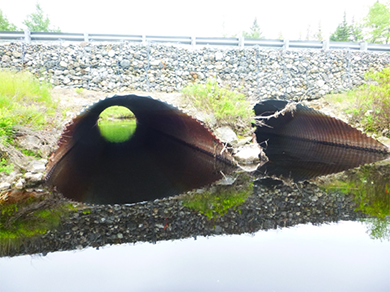
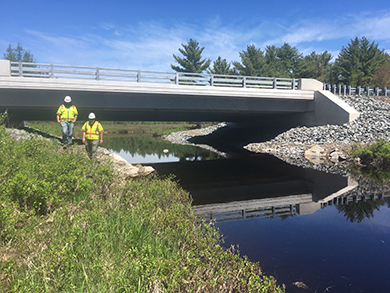
Before (left) and after (right) Pembroke Stream Bridge replacement (Courtesy of MaineDOT)
Project Monitoring Update
Monitoring of completed projects helps MaineDOT ensure improved regulatory compliance and environmental outcomes. In 2018, two culvert replacement projects, completed in 2017, were monitored to help identify potential issues with water flow, stream substrate composition and stability, and sediment deposition.
MaineDOT conducts all monitoring using internal staff, and is satisfied with results from the 2017 sites so far. Each replacement project will continue to be monitored for five years following construction.
Applying Adaptive Management
Adaptive management allows MaineDOT and its partners to ensure all actions maintain the established efficiency and conservation goals through:
- Incorporating new information
- Allowing for real-time program adjustments
- Providing a platform for updating monitoring protocols and avoidance and minimization measures (AMMs)
In 2018, adaptive management was employed for the first time, due to data showing elevated pH levels in grout bag construction projects. Based on this data, an AMM was added that limits the use of grout bags under the programmatic. New Best Management Practices (BMPs) have been proposed to align the impacts with the original biological assessment (BA). These procedures need to be tested in a stream without Atlantic salmon before being implemented in the 2019 construction season.
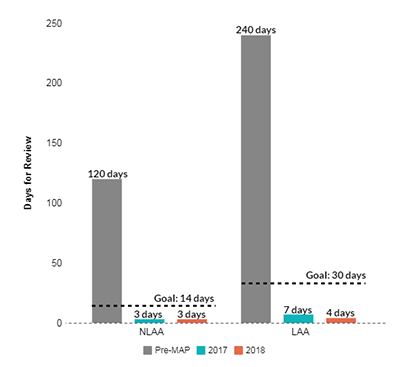
Timeline for project reviews before and after implementation of programmatic (2017 and 2018) (FHWA/Volpe)
Timelines Shorten as Efficiency Improves
Under the programmatic consultation, 36 projects were reviewed for consistency in 2018 (compared to 23 projects reviewed in 2017 and only approximately 7 annually prior to the programmatic consultation). Timelines also improved in 2018; 100% of consultations surpassed initial review goals, compared to only 20% pre-programmatic and 96% in the first year of implementation.
- The programmatic goal for informal consultations, Not Likely to Adversely Affect (NLAA) determinations, is 14 days. Reviews for the 22 projects in this category were completed in an average of 3 days. This timeframe is consistent with that of 2017.
- The goal for formal consultations, Likely to Adversely Affect (LAA) determinations, is 30 days. The 14 projects in this category were reviewed in an average of 4 days. This average review time is 3 days faster than in 2017.
This improvement in efficiency is largely due to:
- Increased familiarity with the streamlined 15-page Project Notification Form (PNF)
- Continued early and frequent contact between MaineDOT and federal permitting agencies
Habitat Restoration and Improvement
Projects completed under the programmatic consultation have led to a total of nearly 188 habitat units, or approximately 4.65 acres, of Atlantic salmon critical habitat restored to help meet the goals of the species recovery plan.
Habitat has been restored through use of the Habitat Connectivity Designs (HCDs) required under the programmatic agreement. These designs help MaineDOT develop and construct culverts to be consistent with natural stream dimensions, profiles, and dynamics to maximize ecosystem function and habitat connectivity.
“We’ve gone from really struggling on a project-by-project basis to being seen as a big restoration advocate. We’re restoring an impressive amount of habitat units on a yearly basis, and we’re being recognized, even in the published recovery plan for the species.”
- Patrick Dockens, USFWS
Maintaining Relationships
MaineDOT has sponsored two HCD trainings (June 2017 and May 2019) for approximately 50 consultants and internal engineers. These trainings help to:
- Improve fish passage design for any stream crossing, not just those processed under the agreement
- Demonstrate a commitment to environmental obligations
- Create more consistent designs that increase predictability
- Foster trust and maintain relationships between the agencies
In-Lieu Fee (ILF) Program
Compensatory mitigation banks allow project developers to pay into a mitigation fund instead of conducting mitigation activities related to their projects. Maine’s ILF program, The Maine Atlantic Salmon Restoration and Conservation Program (ASRCP), was finalized in 2018 in partnership with USACE and USFWS and is administered by the Maine Department of Marine Resources. Although ILF is not currently being used, all parties are engaged in adapting the program to improve its utilization. The ILF is expected to create more flexibility for future mitigation projects under the programmatic.
Lessons Learned
Monitoring maintains quality and trust.
Post-construction monitoring to identify potential issues has helped MaineDOT makes strides toward better environmental outcomes and higher levels of trust between agencies. Active monitoring ensures regulatory compliance, safe and reliable roads and bridges, and the maintenance of high-quality habitats for Atlantic salmon populations. Agencies have been engaged and have aligned their missions to create these encouraging outcomes.
Adaptive management is strategic management.
Allowing for real-time program updates based on new information maintains the efficiency and effectiveness of the program. With adaptive management, MaineDOT is able to strategically address problems without hindering the progress of priority projects. As the program moves forward, adaptive management will continue to be used to integrate important lessons and maintain efficiency.
Practice makes perfect.
Lessons learned in Year One have helped further expedite project delivery. Staff across partner agencies expressed confidence in the relationships that have been formed as a result of the programmatic. Timelines continue to decrease as communication between agencies increases leading to improved efficiency in processing reviews. Lessons from Year Two will be incorporated in the next construction season to make further improvements.
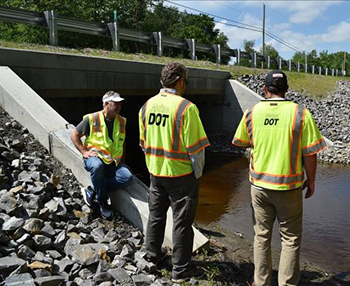
Staff from MaineDOT, USFWS and FHWA inspect a completed culvert replacement in Sidney, ME (FHWA/Volpe)
Next Steps
Keeping up the good work.
Monitoring and continuous follow-ups will be key moving forward. Now that the system is working more effectively, agencies will be able to anticipate and efficiently address future issues. Monitoring and adaptive management will continue to be used to maintain high-quality environments, and agencies will maintain channels of communication to expedite timelines and bring more projects to completion.
For More Information
Contacts
Eric Ham
Maine Department of Transportation
Environmental Office
(207) 215-7356
Eric.Ham@maine.gov
Mike Ruth
FHWA Office of Project Development and Environmental Review
(202) 366-9509
Mike.Ruth@dot.gov
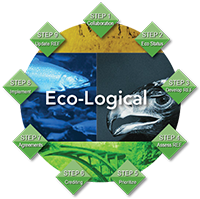
Resources

